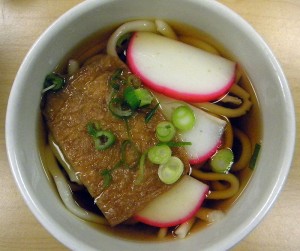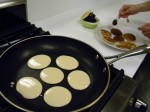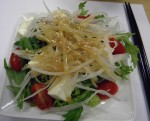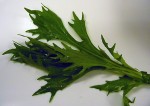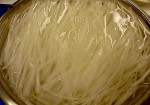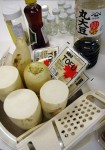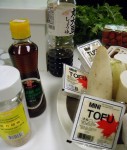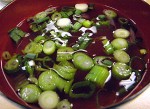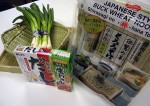Our class started with an introduction to a bewildering array of difficult-to-pronounce ingredients, most of which were to be used in the class recipes.
We were to start with two different noodle ‘soups’, one hot, one cold. The udon noodle soup was the hot soup, made with fresh udon noodles, dashi (a soup stock powder which came in two choices for our class: seaweed and fish), mirin (rice wine) and soy sauce, and was garnished with a pureed fish paste cake (pink and sliceable) and some eggy-looking things (fried tofu) that were fairly sweet and a bit odd.
The dipping sauce/soup for the cold soba noodles had the same ingredients as the hot udon noodle soup; the only difference being that only enough water to dissolve the dashi powder was boiled, and then everything was chilled. Green onions and wasabi paste were added to the dipping sauce at the table.
We also made a daikon and tofu salad. The salad base was mizuna, watercress and leafy endive, layered with tomatoes, soft tofu and finely sliced daikon radish, and dressed with wonderful ‘chukka‘ sesame dressing. I mixed leftover salad with cold soba noodles for a great salad the next day.
The dessert of ‘dorayaki‘ was sweet pancakes traditionally filled with red bean paste, and seasonally with green tea ice cream (summer) or roasted chestnuts (autumn).
Gallery of images from my Japanese Home-Cooking Class, offered by UBC Continuing Studies and taught by Hana Dethlefsen. Hana has her own blog with lots of Japanese recipes and restaurant reviews at: http://letsforking.wordpress.com/
- the traditional dessert of ‘dorayaki’, sweet pancakes filled with red bean paste
- cooking sweet pancakes for the dessert of ‘dorayaki’, traditionally filled with red bean paste, and seasonally with green tea ice cream (summer) or roasted chestnuts (autumn)
- the ingredients for traditional Japanese pancake & bean paste dessert
- the daikon and tofu salad, yummmm!
- mizuna was one of the leafy greens used in the salad. The others were watercress and leafy endive
- daikon radish is soaked for an hour after being finely ‘mandolinned’ and sliced in in order to reduce its pungent flavour.
- daikon radish being ‘mandolinned’
- the ingredients for the daikon and tofu salad showing off the large daikon radishes
- ingredients for daikon salad
- the cold soup/dipping sauce for the soba noodles
- cold ‘soba’ (buckwheat) noodles served with a cold soup/dipping sauce. They look like a pile of rubber bands but taste a lot better…
- ingredients for soba noodle ‘soup’ or dipping sauce
- the hot udon noodle soup with green onion, sweet fried tofu and fish paste cake garnishes
- pureed fish paste cake: pink and sliceable, used to garnish the hot udon noodle soup.
- ingredients for udon noodle soup


